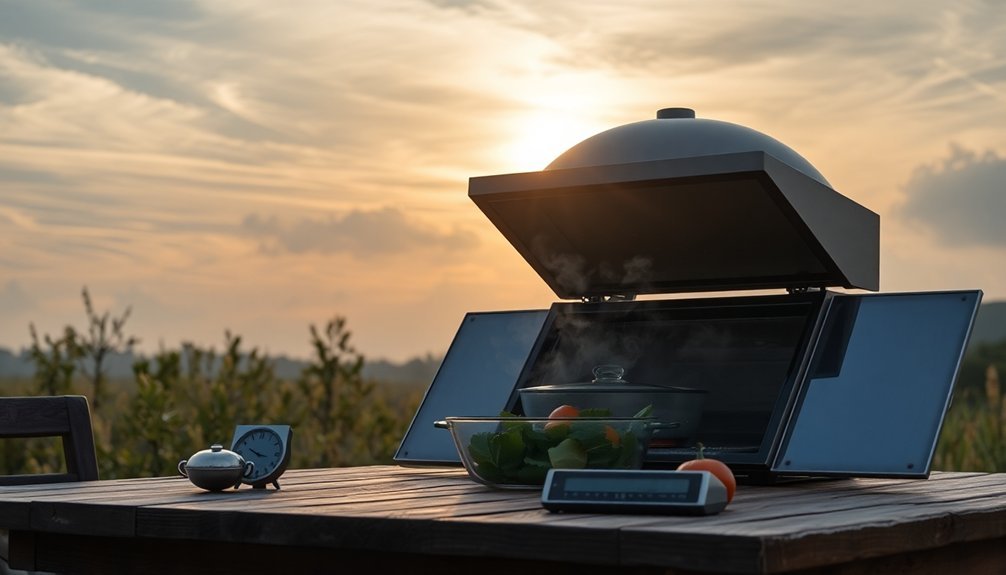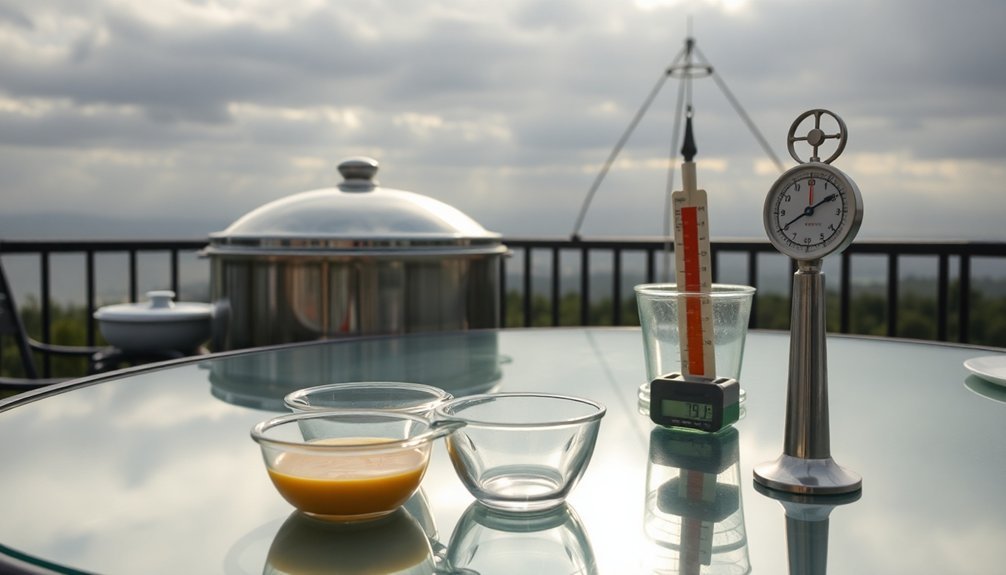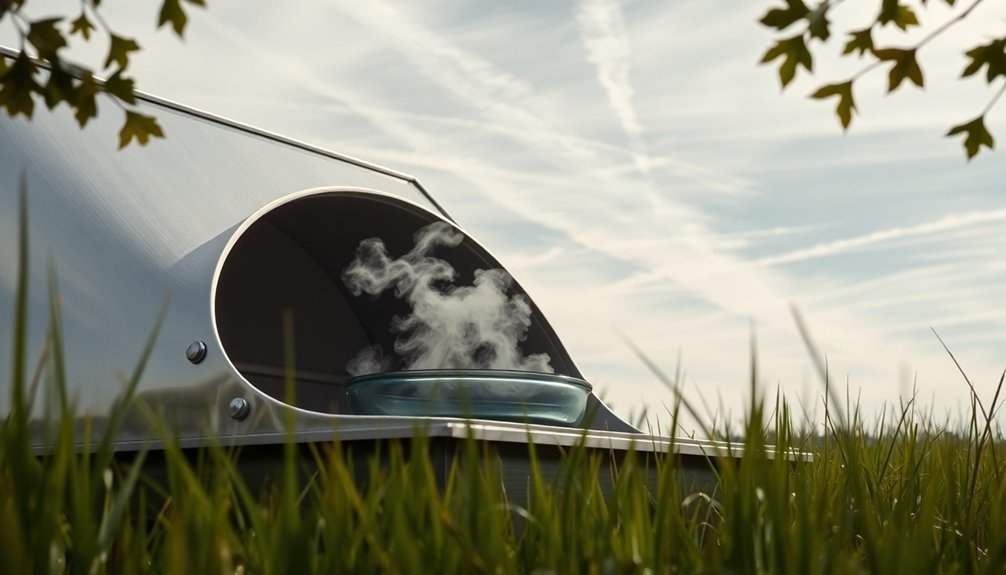On cloudy days, you'll get the best results from your solar cooking by focusing on three proven methods. First, use dark-colored pots with tight-fitting lids to maximize heat absorption when sunlight is limited. Second, choose quick-cooking items like rice, lentils, or pre-soaked beans that don't require extended cooking times. Third, adjust your solar oven's position more frequently – about every 30 minutes – to capture as much available sunlight as possible. You'll want to reduce liquid quantities by 25-50% to maintain moisture during longer cooking times. These adaptations only scratch the surface of successful cloudy-day solar cooking techniques.
Timing Your Solar Meals

When planning your solar meals, timing plays a crucial role in achieving successful results. You'll want to schedule your cooking between 10 am and 3 pm to take advantage of peak sunlight hours, with 11 am to 2 pm being ideal.
During summer months, you can extend your cooking window until 4 pm.
To maintain consistent heat, you'll need to redirect your solar oven toward the sun approximately every hour. Remember that winter requires more frequent adjustments than summer due to shorter days.
Keep in mind that cloud cover can interrupt your cooking process, so it's smart to prepare ingredients in advance and use oven bags when possible. Most foods can be prepared using moist cooking methods that help retain flavor and nutrients.
While delicate foods need closer monitoring, most dishes won't burn in a solar oven, allowing for flexible cooking times as you adapt to weather conditions.
Weather-Ready Solar Cooking Strategies
Since weather conditions considerably impact solar cooking success, implementing the right strategies can help you maintain consistent results even on less-than-perfect days.
On partly cloudy days, stick to quick-cooking items like white rice, lentils, or potatoes. You'll need to use dark pots with tight-fitting lids to maximize heat absorption and monitor temperatures closely as cloud cover can affect cooking times. Using speckled enamel cookware gives you optimal results in variable conditions.
Pre-plan your meals by checking the weather forecast, and prep ingredients accordingly. If you're expecting variable conditions, pre-soak beans or prepare dough ahead of time.
Remember to reduce liquid quantities by ¼ to ½ cup since solar ovens retain moisture well. When clouds roll in, you'll want to adjust your oven's position frequently to catch maximum sunlight and keep it in a wind-protected spot.
Backup Plans That Work

Having reliable backup cooking methods guarantees you'll never go hungry on cloudy days when solar cooking isn't feasible. Your best alternatives include rocket stoves like the Grover model, which efficiently burns small amounts of wood, and butane-powered stoves that work safely indoors with proper ventilation. Creating a dedicated pantry section helps keep all your backup cooking supplies organized and easily accessible.
Keep essential equipment like a cast iron Dutch oven and metal grates ready for these alternative methods.
- Stock your pantry with quick-cooking proteins like sausage and shrimp
- Maintain a supply of non-perishable ingredients including canned goods and dried staples
- Practice using your backup methods before you actually need them
Remember to prioritize safety by ensuring proper ventilation when cooking indoors and using damp wood to control heat during outdoor cooking sessions.
Frequently Asked Questions
Can Solar Ovens Be Used Effectively at High Altitudes During Cloudy Weather?
Yes, you can use solar ovens effectively at high altitudes during cloudy weather. You'll get more UV radiation at elevation, but you'll need to double cooking times and guarantee proper insulation to maintain consistent temperatures.
What Materials Make the Best Insulation for Solar Ovens in Cold Weather?
You'll get the best cold-weather insulation using Firwin Plus or SW1800, layered with foam board. Add a reflective layer and create sealed air gaps to maximize heat retention in your solar oven.
How Do Different Types of Clouds Affect Solar Cooking Temperatures?
You'll get the best cooking temps under thin clouds with only slight reductions. Partial clouds slow cooking moderately, while overcast conditions cut efficiency by 50%. Dense clouds reduce output to 20-30%, making cooking impractical.
Does Air Pollution Impact Solar Oven Performance Similar to Cloud Cover?
No, you won't see air pollution affect your solar oven like cloud cover does. While pollution impacts air quality, it doesn't greatly block sunlight. Your oven's performance depends more on cloud coverage and design efficiency.
Can Solar Ovens Be Used for Baking Bread on Partially Cloudy Days?
You shouldn't bake bread on partially cloudy days in a solar oven. The inconsistent temperatures (200-250°F) won't properly bake your bread. You'll get better results cooking meats, rice, or vegetables instead.
In Summary
Don't let cloudy skies stop you from enjoying solar cooking. With proper timing, adaptable strategies, and reliable backup methods, you'll be able to make sun-powered meals even when conditions aren't perfect. Start checking weather forecasts, positioning your solar cooker during brief sunny breaks, and keeping alternative cooking methods ready. You're now equipped to handle whatever Mother Nature throws at your solar kitchen.





Leave a Reply